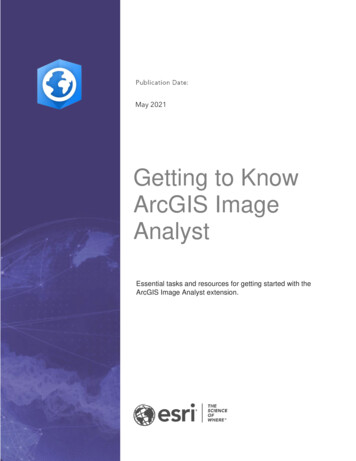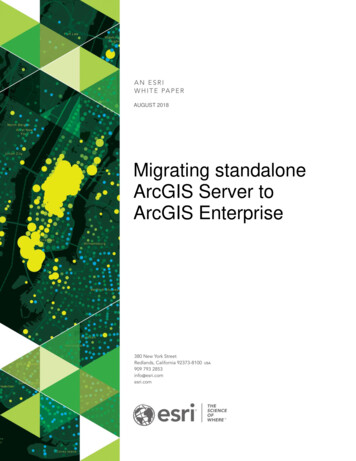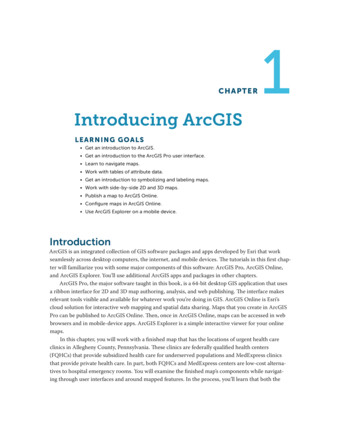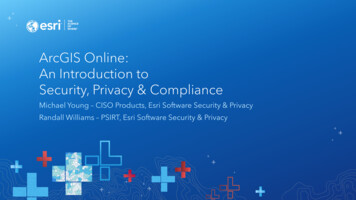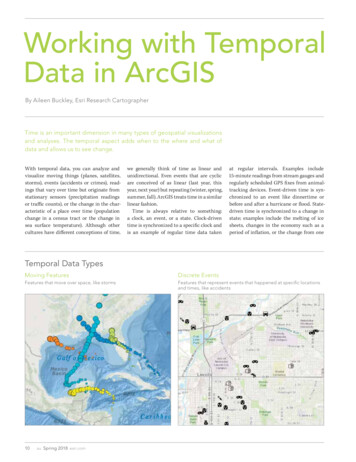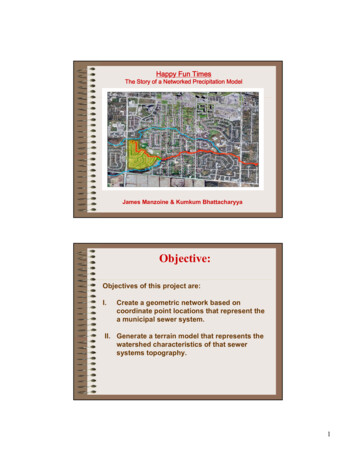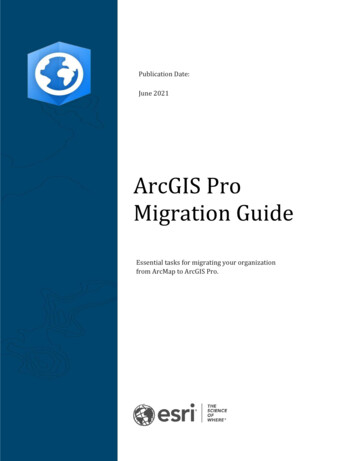
Transcription
Publication Date:June 2021ArcGIS ProMigration GuideEssential tasks for migrating your organizationfrom ArcMap to ArcGIS Pro.
Task checklistTASKCOMPLETE1. Get to know ArcGIS Pro2. Set up ArcGIS Online3. Assign ArcGIS Pro4. Download and install5. Move content to ArcGIS Pro6. Explore with hands-on learning7. Learn moreCopyright 2021 Esri. All rights reserved.2
1. Get to know ArcGIS ProWe’re glad you’ve decided to migrate your organization to ArcGIS Pro, Esri’s nextgeneration desktop GIS. When you have years’ worth of established workflows, data, andskills built around a piece of software, migration can seem daunting. This guide will makethe process manageable, and the benefits that come with ArcGIS Pro will make it wellworth your while.Key characteristics of ArcGIS ProArcGIS Pro is the latest component of ArcGIS Desktop. It isn’t an update to ArcMap, but atotally new application designed to retain the same functionalities while incorporating themost modern technology. ArcGIS Pro features more powerful computing, an intuitive,accessible design, advanced sharing capabilities, and much more.The advantages of migration to ArcGIS Pro include: A modern, fast application: ArcGIS Pro is a 64-bit, multi-threaded application.Its powerful processing and upgraded display engine allow for faster analysisand rendering. An intuitive workspace: Toolbars are replaced by a customizable ribbon whichupdates contextually depending on what you’re doing within the application.Rather than having to dig through toolbars and dialog boxes, the tools you needappear when you need them. Dockable Views and Panes make up your ArcGIS Pro workspace. This means youcan switch back and forth easily between working with symbology orgeoprocessing tools and navigating your maps, tables, and layouts. Project-based design: The working unit for ArcGIS Pro is the project. A singleproject can contain multiple maps, 3D scenes, and layouts. Projects can bepackaged in a few clicks into a convenient format that’s shareable via the cloudor as a file. Alternatively, you can open ArcGIS Pro without a project to completeyour data management tasks. Easy sharing: Thanks to portal integration, you can upload projects, maps, orlayers to your portal at ArcGIS Online (included with your Desktop subscription)Copyright 2021 Esri. All rights reserved.3
or ArcGIS Enterprise. Content is also shared with you through the Portal: theArcGIS Living Atlas of the World is an Esri-curated resource of data andbasemaps, and millions of third-party datasets have been made available for freeon ArcGIS Online. All this data is accessible from within the application. ArcMap compatibility: Maps, layouts, symbology, and models created in anyArcMap version can be ported into ArcGIS Pro with minimal changes. Pythonscripts can be easily updated to work in ArcGIS Pro. Once your projects are inArcGIS Pro, you’ll find all the same functionality available (with very fewexceptions) plus new updates not available in ArcMap. ArcGIS Pro projects can’treturn to ArcMap, but you can continue to run both ArcGIS Pro and ArcMap fromthe same machine and use the same data sources.A solution for real-world problemsFrom artistic mapping to data-driven analysis to 3D models, ArcGIS Pro has a wide range ofcapabilities that are utilized across an equally diverse array of industries. With yourArcMap background, you probably already know what your organization plans to do withArcGIS Pro, but the sampling of scenarios below will demonstrate how ArcGIS Pro can beused to approach a variety of problems in a new way.Each scenario is accompanied by a hands-on learning exercise, which you or yourcoworkers can return to after completing the other tasks in this guide. Even forexperienced GIS users, switching software is a bit of a learning curve. Hands-on exercisesare an informative, fun, and effective way to get familiar with ArcGIS Pro’s design andcapabilities. Cartography: In ArcGIS Pro, you can make beautiful maps and visualizations toevoke a sense of place while communicating data in a compelling way. Forexample can visualize public health trends such as shrinking malaria rates, butthe possibilities are nearly endless. ArcGIS Pro was used to make most of therecent entries in the Maps We Love gallery, Esri’s curated collection of the bestcartography. Spatial Analysis: In industries ranging from retail to natural resources tonational security, ArcGIS Pro helps professionals use data to address complexspatial issues. See how conservation scientists can use machine learning topredict important seagrass habitat.Copyright 2021 Esri. All rights reserved.4
3D GIS: You can analyze data in both 2D and 3D within the same ArcGIS Proproject. Advanced 3D models provide the visualizations needed to makeimportant decisions, as with this model of proposed urban development.Note: ArcGIS Pro has somewhat different system requirements than ArcMap. Beforeproceeding, make sure you meet them. Get the details here.Copyright 2021 Esri. All rights reserved.5
2. Set up ArcGIS OnlineIf you have an ArcGIS Desktop subscription, you already have ArcGIS Pro licenses and anArcGIS Online subscription. ArcGIS Online will provide the portal connecting you and yourteam members. The portal will enable sharing, give access to data, and allow teammembers to use their ArcGIS Pro licenses across multiple machines. As you’ll learn in thenext section, it’s also where you’ll manage licenses. There’s a little more setup involvedthan simply downloading licensing files like you did for ArcMap, but this portal connectionis what allows ArcGIS Pro to use the type of cloud-based collaboration that has become theworkplace norm.Note: If you have an ArcGIS Enterprise deployment, skip this section; you’ll use Portalfor ArcGIS for licensing and collaboration.For detailed information on setting up ArcGIS Online, see the ArcGIS OnlineImplementation Guide. You won’t need to read the entire guide – just follow the stepsoutlined in the Activate your subscription (page 4) and Add members (page 8) sections.Your main use for ArcGIS Online will be to manage ArcGIS Pro licenses.Tips Use existing Esri accounts: If your team members have set up Esri accounts forother purposes in the past, when adding them to the organization, select theoption to invite using an account of their choice. This way, they won’t have tomerge two accounts. Questions about account merges can be directed to EsriCustomer Service. Enable Esri Access: This setting must be enabled if you want members to accesssites such as Esri Training, Esri Support, Esri Community, and My Esri. Find outhow.Copyright 2021 Esri. All rights reserved.6
3. Assign ArcGIS ProFor all ArcGIS Desktop apps except ArcGIS Pro, your license type is either Single Use orConcurrent Use. You’re probably accustomed to using ArcGIS License Manager to provisionlicense files on a per-machine basis. As mentioned previously, however, ArcGIS Pro defaultsto Named User licenses, which are associated with user accounts.For each ArcGIS Desktop license your organization has, you also have a Creator user typethrough ArcGIS Online and an ArcGIS Pro add-on license. Your ArcGIS Pro addon licensesare of the same level – Basic, Standard, or Advanced – as your ArcMap licenses.To give someone access to ArcGIS Pro, you assign the user type and add-on license inArcGIS Online. You can re-assign them to different people if your team members change.These members, in turn, can log in and use ArcGIS Pro on any machine where the programis installed. This allows for added flexibility in the workplace.If you use ArcGIS Enterprise, learn how to configure ArcGIS Pro licenses in Portal forArcGIS.Alternative licensing optionsThough licensing through ArcGIS Online is the default, it isn’t required for ArcGIS Desktopsubscribers. You can keep the licensing setup you use for ArcMap by converting one ormore of your ArcGIS Pro add-ons to Single Use or Concurrent Use. Organization memberscan still sign in to ArcGIS Online to share maps and access web content, but theircredentials are not associated with a license. Instead, the license must be authorizedseparately for each machine, as with ArcMap.Copyright 2021 Esri. All rights reserved.7
4. Download and installNow that you’ve assigned ArcGIS Pro to team members, your organization’s primarymaintenance contact can download and install ArcGIS Pro. This is the person whocommunicates with Esri Customer Service and keeps your subscription active. If you’re notsure who your primary maintenance contact is or would like to specify a new contact, reachout to Customer Service. If you don’t have this role, forward this section to the person whodoes.Get the steps to download and install ArcGIS Pro from My Esri.Tips Link your organization: Before downloading ArcGIS Pro, you must link yournew ArcGIS Online organization to My Esri. To do this, log into My Esri, click theMy Organizations tab and follow the prompts to request permissions. Authorize if necessary: If you’ve already assigned use types using ArcGISOnline, organization members simply need to log in when starting ArcGIS Pro. Ifyou converted licenses to Single Use or Concurrent Use, you should havereceived an email with authorization numbers and further instructions. You canalso find this information in the licensing area of the My Organizations tab in MyEsri. Learn about authorizing single use and concurrent use licenses.Allow members to download their own softwareFor security and management reasons, organization members are not able to downloadArcGIS Pro by default. As the administrator, you may want to oversee the downloadprocess. Alternatively, but you can allow each member to download their own software.Copyright 2021 Esri. All rights reserved.8
5. Move content to ArcGIS ProThe process of bringing your ArcMap maps, scenes, and layouts into ArcGIS Pro isstraightforward. You can also import your favorite styles and Python scripts. Depending onyour organization structure, you may find these workflows useful yourself, or you mightwant to forward them to team members.Import an ArcMap document to ArcGIS ProYou can import maps (.mxd), scenes (.sxd) and globes (.3DD) into ArcGIS Pro projects(.aprx). Depending on your planned workflow, you might find it more convenient to importseveral of these documents into a single project.Begin with any ArcGIS Pro project and use the Import Map button on the ribbon to browseto the desired file. When the map opens, it should look the same as it does in ArcMap. Youcan check your Notifications to read messages about the import. Read detailed steps.Import your styles to ArcGIS ProArcMap styles (.style) must be converted to ArcGIS Pro styles (.stylx). There are two waysto do so. Many styles have already been converted for ArcGIS Pro and are available throughArcGIS Online. Learn how to search for and add styles. Alternatively, you can import a styleyou have saved locally. Learn how to import styles.Modify your Python scripts for ArcGIS ProArcGIS Pro uses Python 3 while ArcMap uses Python 2. Therefore, scripts and customgeoprocessing tools written for ArcMap may need to be modified to work in ArcGIS Pro.The geoprocessing tool Analyze Tools For Pro can highlight areas of code where changesmust be made, and the Python 2to3 utility can automate much of the process. Learn moreabout Python migration.Copyright 2021 Esri. All rights reserved.9
6. Explore with hands-on learningIn ArcGIS Pro you’ll have access to the newest advances in desktop GIS while still beingable to do virtually anything you’ve done in ArcMap. However, you’ll need to spend sometime working with the software to orient yourself. ArcGIS Pro’s intuitive design facilitateslearning, and a wide variety of lessons and documentation is available to guide you.Get started using ArcGIS ProFor a thorough introduction to ArcGIS Pro, consider watching this seminar for ArcMapusers or completing this introductory course. Then, revisit the case studies at the beginningof this guide, and follow the accompanying tutorials.Copyright 2021 Esri. All rights reserved.10
7. Learn MoreMigrating to ArcGIS Pro will be a learning process for you and your team. The resources inthis section will help you troubleshoot, answer questions, and find further training courses. More in-depth guidance for your transition to ArcGIS Pro is provided in the bookSwitching to ArcGIS Pro from ArcMap by Maribeth H. Price. For more hands-on learning experience, there are dozens of free lessonsavailable at Learn ArcGIS. A variety of educational resources can also be found atEsri Training. Join the ArcGIS Pro community on Esri Community. Here you can joindiscussions and read blog articles from a diverse group of ArcGIS Pro users andEsri staff. For even more news direct from Esri teams, follow the ArcGIS Blog. Browse the ArcGIS Pro Resources page. This is your hub for all things ArcGISPro: news, learning materials, videos, documentation, and more.Troubleshooting and supportLooking for assistance with ArcGIS Pro? Walk through this list. The ArcGIS Pro Help is searchable by keyword and contains documentation foreverything from program set-up to individual tools. Consult the Esri Community and get specific answers from peers and membersof Esri’s ArcGIS Pro teams. If you’ve exhausted these options and still need help, contact Esri TechnicalSupport for technical issues or Esri Customer Service for licensing questions.Copyright 2021 Esri. All rights reserved.11
FAQHow close is ArcGIS Pro to having the same functionality as ArcMap?Very close. Esri teams have been working for several years to close the remaining gapsbetween ArcMap and ArcGIS Pro, while simultaneously advancing Pro with completely newfunctionalities. You can see a list of tools that are not available in ArcGIS Pro here.Will ArcGIS Pro replace ArcMap?Yes, eventually. Esri is now focusing on developing ArcGIS Pro as its main desktop GIS butwill continue to maintain ArcMap for years to come.If I have ArcGIS Desktop, what license do I have for ArcGIS Pro?Every ArcGIS Desktop license comes with an ArcGIS Pro add-on license at the same level(basic, standard, or advanced) as you originally selected for ArcMap, as well as ArcGIS Proequivalents of any extensions. For example, if your organization has three Desktop licenseswith Standard level ArcMap and the Spatial Analyst extension, you also have threeStandard level ArcGIS Pro licenses with Spatial Analyst. The add-on and extensions can beused with a Creator ArcGIS Online user type, (also included with ArcGIS Desktop) orconverted to Single Use or Concurrent Use.Can I bring an ArcGIS Pro project into ArcMap?Unfortunately, ArcGIS Pro projects are not backward compatible with ArcMap. However,the two programs can use the same data and thus collaborate through a shared data source.Can I run ArcMap and ArcGIS Pro on the same machine?Yes. You can keep any version of ArcMap on your computer and still download and useArcGIS Pro.Copyright 2021 Esri. All rights reserved.12
the possibilities are nearly endless. ArcGIS Pro was used to make most of the recent entries in the Maps We Love gallery, sri's curated collection of the best cartography. Spatial Analysis: In industries ranging from retail to natural resources to national security, ArcGIS Pro helps professionals use data to address complex spatial issues.

